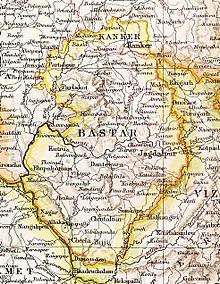| Bastar State | |||||||
|---|---|---|---|---|---|---|---|
| Princely State of British India | |||||||
| 1324–1948 | |||||||
|
Flag | |||||||
 Bastar State in the Imperial Gazetteer of India | |||||||
| Capital | Jagdalpur | ||||||
| Area | |||||||
• 1901 | 33,831 km2 (13,062 sq mi) | ||||||
| Population | |||||||
• 1901 | 306,501 | ||||||
| History | |||||||
• Established | 1324 | ||||||
| 1948 | |||||||
| |||||||
| Bastar Princely State | |||||||
Bastar state was a princely state in India during the British Raj. It was founded in the early 13th century by Annamaraja, a brother of the last ruler of the Kakatiya dynasty, Prataparudra II.
It is today used to refer to the same region, called Bastar division in Chhattisgarh state.[1]
In the early 19th century, the state became part of Central Provinces and Berar under the British Raj, and acceded to the Union of India on 1 January 1948, to become part of the Madhya Pradesh in 1956, and later part of the Bastar district of Chhattisgarh state in 2000. The current ceremonial ruler is Maharaja Kamal Chandra Bhanj Deo, of the Kakatiya and Bhanj dynasty.
- ^ Rahul Pandita. Hello Bastar: The Untold Story Of India’s Maoist Movement. Tranquebar Press (2011). ISBN 978-93-8065834-6.Chapter VI. p. 111
